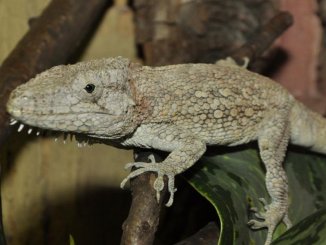The Senegal chameleon is a medium-sized arboreal lizard native to Senegal and other west African countries.
These reptiles are solitary creatures and should not be over-handled.
They love to explore and climb and will experience subtle color changes, making them wonderful creatures to observe.
Senegal chameleons are not very easy to care for, and can easily develop health issues if their basic needs are not met.
Because of this, they are best suited to intermediate to experienced reptile owners.
Senegal Chameleon Overview
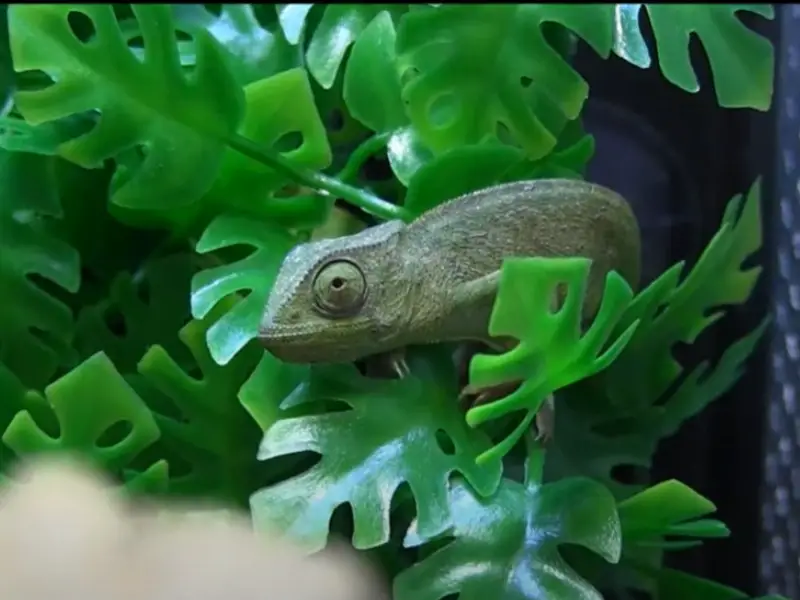
| Common name | Senegal Chameleon |
| Scientific name | Chameleo senegalensis |
| Natural habitat | Gallery forests and moist savannahs |
| Adult size | 6 - 8 inches long (including their tail). |
| Average lifespan | 5 years |
| Diet | Carnivorous (worms, roaches, and crickets). |
| Housing | Screened enclosure (approximately 18 inches by 18 inches by 24 inches). |
| Experience | Intermediate to experienced |
Origin
The Senegal Chameleon (Chameleo senegalensis) is a type of chameleon found throughout equatorial Africa.
It is native to West Africa specifically.
As the name suggests, one of its countries of origin is Senegal.
However, this chameleon does not only originate from Senegal but also from surrounding countries, including Nigeria, Cameroon, and Mali.
It is pretty common and is found throughout these regions, inhabiting moist savannahs and gallery forests.
The IUCN Red List categorizes this chameleon as Least Concern due to its widespread origin.
But, the pet trade of this species is cause for concern so if you’re interested in keeping one, only buy a captive-bred chameleon from a reputable breeder.
Appearance And Behavior
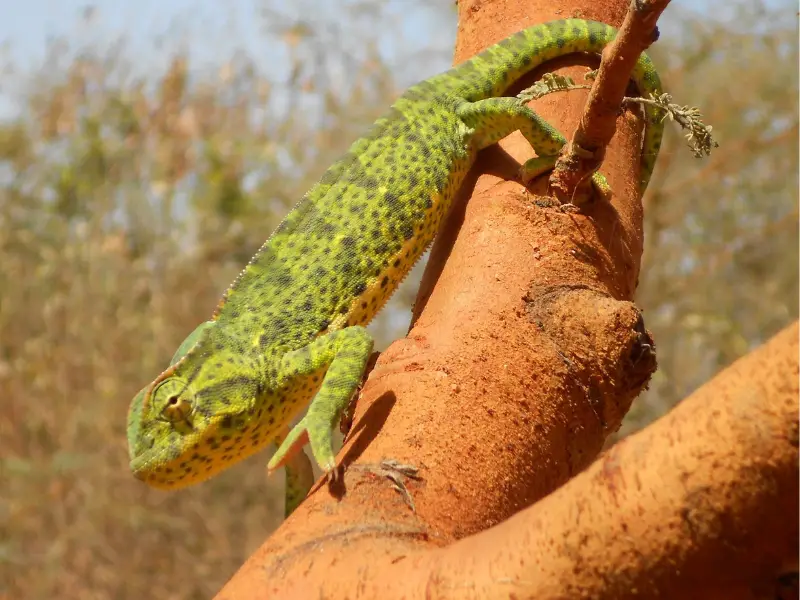
The Senegal chameleon does not have the bright colors and intricate patterns of some other reptiles that are sought after by many reptile lovers. However, they are a chameleon, and therefore change color.
If you watch them closely, you will notice subtle changes to their coloring and patterns throughout the day.
Their base color is usually light brown but they subtly change color according to their environment and even their mood!
For example, your chameleon should turn a green color with black spots when it is relaxed and resting.
It should go a light brown color with brown patterns and spots when it is basking.
They should also change colors when they are hunting, roosting, mating, and more!
These chameleons have very long, curled tails. Their feet are zygodactylous, which means that they have two toes that are facing forward and two toes that are facing backward.
These features, combined with their bulging eyes and cubed head, give them a distinct, chameleon look. However, they can be distinguished from other chameleons by a small flap on their neck.
They are shy creatures and prefer to be alone.
They tend to get very stressed if exposed to other creatures (humans included!). They are much happier just exploring their surroundings.
Size And Lifespan
The average adult Senegal chameleon is between six inches and eight inches long. This measurement includes their long tail.
The females are typically a little bit bigger than the males. However, the size difference is not huge. Not all female chameleons will be longer than their male counterparts.
Typically, these chameleons will live for about five years when they are kept in captivity. However, this is only the case if they are looked after properly.
You need to feed them the right food and handle them with great care.
These chameleons are quite delicate. If their basic needs are not met, it is very unlikely that they will live for five years.
Temperament
Senegal chameleons are incredibly shy and solitary creatures. If you have one as a pet, you should avoid touching them as much as possible.
They do not get along well with other pets (including their own kind).
In fact, they have been known to get stressed out by their own reflection.
If you keep more than one in an enclosure they may even fight with one another (especially if they are both males).
This is not the reptile for you if you want to handle your pet regularly.
However, simply watching a Senegal chameleon can be incredibly rewarding. You can track their mood by color changes.
If your chameleon is not as vibrant and bright as usual, it is a sign that they are feeling a bit gloomy.
If they turn dark shades of brown or black, chances are they are pretty upset.
When your chameleon is colorful and bright, it is a sign that everything is going well and they are feeling happy.
These chameleons are adventurous, and to keep them happy you should provide them with lots of objects to explore and climb.
The more foliage there is, the happier your chameleon will be.
Chameleons are very unlikely to bite their owner.
Before they do, they will usually send warning signs, like changing color, hissing, and mouth gaping.
If you notice this behavior, stop handling the chameleon immediately.
Should you get bitten, don’t worry!
Chameleons are not venomous, and their bites are rarely serious.
Just make sure you clean the wound and watch it carefully for any signs of infection.
Housing A Senegal Chameleon
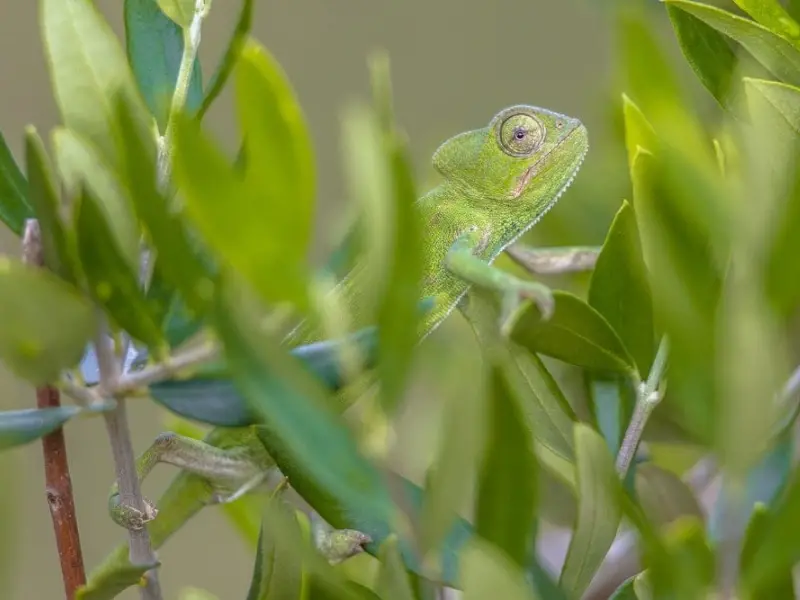
Chameleons originate from moist savannahs and gallery forests. This is something to bear in mind when housing them.
Everything from the hum
When you know what needs to be done, it can be really fun to create a comfortable and inviting space for your chameleon.
Enclosure Size
When you are creating a home for your chameleon, your first step is going to be sourcing an enclosure.
When choosing a physical structure, there are a few things you need to keep in mind.
First, these chameleons love to climb.
You should aim to choose an enclosure that has some height so that you can decorate it with structures that your chameleon can explore.
It’s best to choose something that has more height than width.
Ideally, you should aim for an enclosure that is at least 18 inches by 18 inches by 24 inches.
Second, these chameleons need a lot of fresh air.
If they don’t get good air circulation, they can develop respiratory infections.
Therefore, you should get an enclosure that is screened or that has mesh sides. This will help air flow through their enclosure.
Lighting
To keep your chameleon healthy, you will need to mimic the lighting conditions of its natural habitat.
Chameleons need sunlight to help regulate their appetite and metabolism, as well as synthesize vitamin D3.
Vitamin D3 is very important for Senegal chameleons, as it plays a vital role in strengthening their joints and bones.
If possible, expose your Senegal chameleon to some natural sunlight every day.
However, since this is not always feasible, you should invest in some UV lamps.
We recommend ones that have a timer so that you can set them to go on for 12 hours during the day and off for 12 hours at night.
Temperature
Chameleons need to alternate between the warmth for basking and the cool to regulate their body temperature.
So, you will need to set up a warm area on one side of the enclosure, and a cooler area on the other.
You can use a basking light or even just a 60-watt light bulb for the warm area.
However, make sure that the bulb is not inside the enclosure, or else your chameleon could burn itself.
The basking area should be between 85 and 90°F.
The rest of the enclosure (ie the cooling area) should be between 74 and 80°F (although can get to as low as 72°F at night).
Install thermometers in the warm and cool areas of their enclosure so that you can keep track of the temperature.
Chameleons also need UVB light to stay healthy when kept in captivity.
UVB lighting mimics sunlight, enabling your pet to synthesize Vitamin D, which prevents metabolic bone disease.
So you’ll need to place a UVB light at the top of the enclosure.
It should be about 12 inches away from the highest point your chameleon can reach by climbing so that there’s no risk of your pet burning itself.
Humidity
Humidity is another element you have to nail if you want to keep your chameleon happy and healthy.
Their natural habitat is moist, and you must do your best to mimic this in their enclosure.
Ultimately, you should aim to keep a humidity level between 60% and 90%. There are two ways you can do this.
First, you could use a spray bottle to manually spray the enclosure with mist a few times a day.
Alternatively, you could invest in an automatic drip or mist system.
This will not only help you manage the humidity but also provide your chameleon with drinking water (more on this later).
Whichever method you choose, use a hygrometer to help you track humidity levels.
Substrate And Decoration
Lucky for you, your Senegal chameleon’s enclosure will not need a specialized substrate.
You can use one if you want, but it is completely fine to just use a reptile carpet or even old newspapers.
With these chameleons, it’s the decoration that is important.
The enclosure’s decoration is not just for aesthetic purposes but it provides the chameleon with a playground to climb and explore.
Your main decorations should be plants. Real plants are ideal, but fake ones will do if you have no other choice.
Use high plants so that your chameleon can climb. The higher they are, the safer they feel.
Your plans should also be pesticide-free and non-toxic to keep your chameleon safe.
When choosing plants, avoid bright colors, as these can cause your chameleon distress.
Double-check that your plants won’t develop bright flowers either.
Some live plants that are suitable for chameleons are ficus, golden pothos, and hibiscus.
Cleaning
It goes without saying that you have to keep your chameleon’s enclosure clean.
Do a spot clean every day, wiping away any dirt that may have accumulated.
You should also keep an eye on the substrate you are using.
Each one will be different, so research your substrate of choice and ensure that you replace it regularly.
You should also just stay aware of the state of the enclosure. If it starts to smell or look dirty, it’s time to give it a clean!
Senegal Chameleon Care
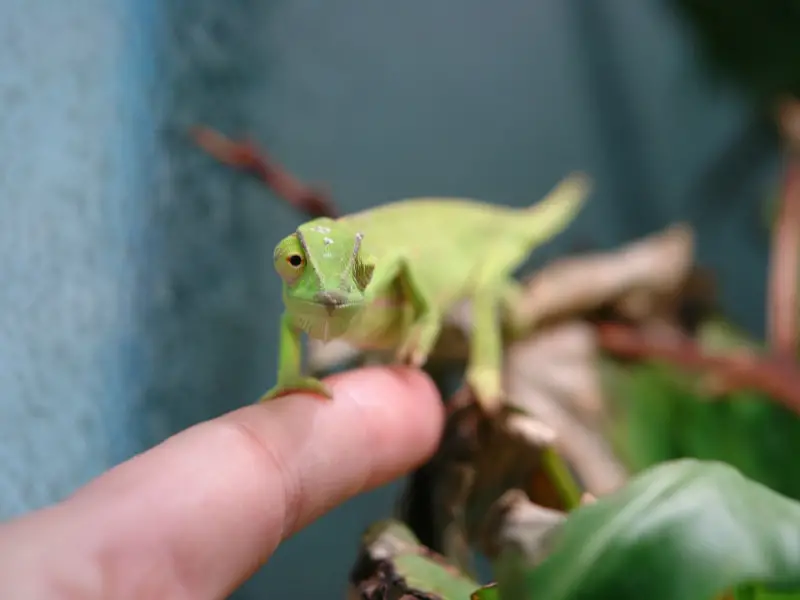
Looking after these chameleons boils down to meeting their basic needs and avoiding over-handling.
Apart from their housing needs, you need to ensure that you are giving them enough food and water, as well as watching out for, and preventing, common health issues.
Food And Water
Senegal chameleons require a lot of water so you’ll need to provide them with a constant supply.
However, to complicate matters, chameleons don’t drink water from bowls.
Rather, they choose to lick water droplets off surfaces, like foliage.
Therefore, you will need to figure out a way to give them a constant supply of water they can lick off surfaces.
The right humidity system should do this for you.
An automatic drip or misting system will coat your surfaces in water droplets for your chameleon to drink.
Alternatively, if you are manually spraying the enclosure enough, this too should provide the chameleon with sufficient drinking water.
Make sure that there are wet leaves in the enclosure that your chameleon can drink from.
Senegal chameleons do not only require a lot of water. They also need a lot of food.
They are carnivores and love eating a protein-rich diet of live insects. Mealworms, Dubia roaches, and crickets are all good options.
It’s a good idea to dust their food with vitamin and calcium powder to give them extra nutrients.
This will help prevent certain health issues like bone disorders.
You should aim to feed your Senegal chameleon every second day – ideally in the morning to help with digestion.
If you are feeding them crickets, give them between 5-10 crickets every second day.
If you choose mealworms or roaches, give them 3-4 every second day.
Whichever food you are using, it is a good idea to track how much the chameleon is eating and adjust accordingly.
Uneaten prey could bite your chameleon, or die and decompose.
Handling
The motto of handling a Senegal chameleon is to “look and not touch.”
You should avoid handling them as much as possible, and only do so when absolutely necessary.
When handled, chameleons can become very distressed.
Some owners have trained their chameleons to endure being handled. However, the chameleon is very unlikely to enjoy it.
These chameleons are happiest when left in peace to adventure and bask.
Common Health Issues
Senegal chameleons are quite delicate creatures so there are several health issues to watch out for.
First, they are susceptible to intestinal parasites, especially if they have been caught in the wild. Make sure to get fecal tests done regularly.
They are also prone to metabolic bone disease, especially if they are not given enough UV light and calcium.
Use a UV light and spray their feeder insects with calcium powder to decrease their chances of developing this disease.
Respiratory infections are another health issue to watch out for.
These can develop if there is insufficient air circulation in their enclosure, or if they are eating a poor diet.
These chameleons are easily stressed, and this can really harm their immune system.
Avoid handling your chameleon and exposing it to bright colors and other animals.
If your chameleon starts exhibiting any strange behavior or symptoms, it’s best to get it checked out by a reptile vet as soon as possible.
Breeding
The breeding of Senegal chameleons is pretty risky and complicated.
Healthy females can lay two to three clutches of eggs per year with between 15 and 70 eggs per clutch.
However, these chameleons do not breed regularly so it can be difficult to successfully breed your pair.
Females can become aggressive toward males after laying eggs.
So if you manage to breed your chameleons, make sure you remove the male from the enclosure after the eggs are laid.
Note that young chameleons are incredibly delicate and can die very easily from stress or other health concerns.
This can be frustrating and heartbreaking for the owner.
Therefore, we don’t recommend breeding Senegal chameleons unless you are an experienced breeder.
Choosing A Senegal Chameleon
Senegal chameleons are sensitive and solitary pets, which can be incredibly rewarding for experienced owners who do not need to handle their pets regularly.
They are very affordable and typically cost around $35. However, this just covers the chameleon.
You will have to spend a lot more to ensure your chameleon is suitably housed and fed.
Like most reptiles, you must source your Senegal chameleon from a reputable breeder.
Chameleons that have been caught in the wild may have a lot of health issues.
It’s a good idea to watch a chameleon eat before you buy it.
If it refuses to eat, this is a sign that it may not be entirely healthy.
Also, make sure that its eyes are clear and that there isn’t excess mucus around its nose or mouth.



